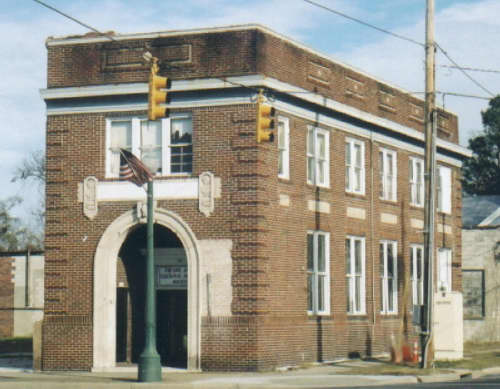Historical Background
Contributed by Sloan Mason
Kinstons principal black commercial district has traditionally been located
along Queen Street south of King Street, and it is in this section that the
firm later chartered as The Peoples Bank had its beginnings. Between 1902 and
1908 a group of black businessmen organized Holloway, Borden, Hicks and
Company, to engage in the banking business. The 1908 Kinston City Directory
indicates that the company's capital was $2,275. Its officers were president T.
B. Holloway, a grocer; first vice-president J. H. Jones, a tinner; second
vice-president C. H. Bynum, a physician; and cashier J. G. Banton, a barber.
The banking company operated in a two-story frame building which faced north on
Bright Street at its southeast corner with South Queen Street; J. H. Jones and
his roofing business occupied the other half of the building. Across Bright
Street from that site is The Peoples Bank Building. By 1916, the name of the
company had been changed to Holloway, Murphy and Company, although Murphy has
not been identified. The company retained the same officers and continued to
occupy the Bright Street building.
In January 1921, the company obtained a charter to operate as the Peoples Bank
with capital stock of $25,000. Subscribers included T. B. Holloway, J. G.
Banton, C. H. Bynum, and Holloway, Murphy and Company. The objectives of the
company were listed as follows:
(1) To conduct a commercial banking business;
(2) To conduct a savings banking business;
(3) To do a general trust business in all its phases, and to
have all the power incident thereto;
(4) To act as fiscal agent, factor, executor, administrator
or trustee for any person, firm or corporations upon such
terms as may be agreed upon.
The officers remained the same. In announcing the chartering of The Peoples
Bank, the Daily Free press stated the following:
The company has been conducting a banking business a number of years, and has
done much to encourage the saving habit
among colored residents. White bankers of the city recommended the granting of
the charter.
The peoples Bank continued to operate in the Bright Street building for about
two years after its chartering.
The apparent success of The Peoples Bank soon demanded that the company move to
a more substantial building which would reflect the position of the firm in the
black community. The 1923 Kinston City Directory indicates the bank was still
operating from the Bright Street location, but by June 1925 it had moved to a
new brick-veneered two- story Classical Revival building on the northeast
corner of South Queen and East Bright streets. Holloway, Bynum and Banton again
appear as officers of the bank in the 1928 city directory, with grocer Starr
Hicks, a long-time director, serving as one of th vice-presidents.
Unfortunately, The Peoples Bank seems to have suffered the same fate as many
other banks during the Great Depression. Deed records indicate that Gurney P.
Hood, North Carolina Commissioner of Banks, was forced to sell the bank's real
estate in 1931, presumably after its failure. Coy Turner acquired the building
in 1933 and operated a dry cleaning business there for more than twenty years.
Other occupants
_ have included black dentist, Dr. Richard Foy; lawyer McKinley Battle; and a
branch of North Carolina Mutual Life Insurance Company, the nation s largest
black-owned and managed financial institution. Henry G. Dove purchased the
property in 1959 and operated a barber shop on the first floor.
|
 The Peoples Bank
The Peoples Bank

